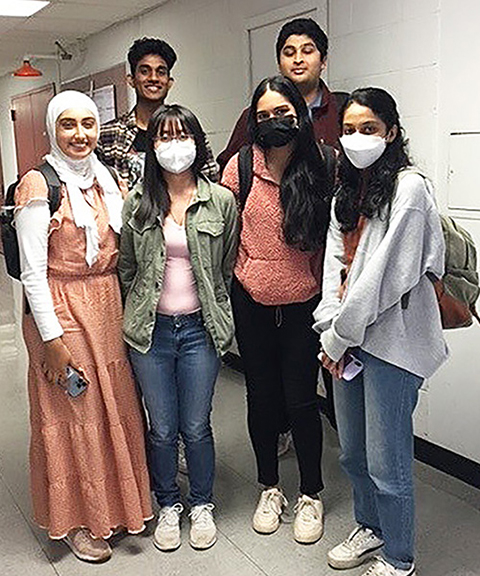
What I’ve learned about water, aging and protein quality control
When I was a biology student at the Chinese University of Hong Kong, I learned about living organisms, cells and their building blocks such as nucleic acid and proteins. I do not recall a focused discussion about the water molecule or the importance of water to life.

Water is simple, ubiquitous and taken for granted. I did not appreciate the importance of water in biology and life until late in my science career.
I have always been interested in quality control, or QC. In biology, molecular chaperones are important for the proper folding and quality control of our proteome, particularly under stress. Not surprisingly, transient hyperthermia, or overheating, increases the expression of these protein chaperones, thus the term “heat shock proteins,” or HSPs. In the early days of my work, I reasoned that the dysfunction of this protein QC mechanism likely contributed to age-related dys-homeostasis and vulnerability to diseases.
My lab’s first publication on this appeared in the Journal of Biological Chemistry in 1989. This and related studies from other labs on cells, animals, and human peripheral lymphocytes suggest that the proteome declines with age and under stress. We hypothesized HSPs helped maintain protein homeostasis and diminished HSP production would contribute to age-related deterioration and vulnerability to diseases, in particular, neurodegenerative diseases, such as Huntington’s that are known for disease protein aggregates.
When we acquired a cell model that expressed a reporter disease protein of Huntington’s disease, or HD, we tested whether a heat shock–induced increase in HSP chaperones — which support protein structure and function in cells under stress — would prevent the misfolding and aggregation of the disease protein into what are called inclusion bodies, or IBs.
To our surprise, HS and HSP chaperone expression increased the abundance of IBs at the expense of the soluble and diffusible form of the reporter protein. We could not make sense of all these round, fluorescent-green, micron-size entities in our heat-shocked cells. The result was the opposite of what we expected.
We combed the literature to figure out what it meant, and we quickly realized that a protein's amino acid sequence determines its folded 3D structure, which then determines its biological function.
Evidence has been accumulating for more than two decades that 30% to 50% of the proteome of higher eukaryotes, in their native and functional states, is disordered and unfolded, entirely or in parts. Their amino acid composition — low in hydrophobic and high in charged amino acid residues — lacks the driving force of hydrophobic collapse needed to fold and compact into a defined 3D structure in a water-based cell environment.
These natively unfolded, functional proteins are termed intrinsically disordered proteins and proteins with disordered regions. They are exquisitely sensitive to cell crowding and changes in cell hydration and are overrepresented among regulatory proteins including proteins implicated in cancer and neurodegenerative disease, prompting what researchers called the “disorder in disorders” or “D2” concept to underscore this intimate association of structural disorder of disease proteins and disease pathogenesis.

That reporter disease protein of Huntington’s we’d studied is intrinsically disordered in structure.
Many neurodegenerative diseases are known to be age related. Symptoms of autosomal dominant diseases such as HD show up late in life, reflecting the age-related changes in the cell environment that allow the disease to progress. Both lay and scientific evidence shows that aging — from yeast to human — is associated with decreased hydration and changes in water homeostasis.
The human brain’s structure and function make it particularly vulnerable to such age-related changes. Our rigid skull limits how much tissue can expand or shrink, and neurons lack aquaporin for water transport. Further, many compatible organic osmolytes for tonicity and volume control in peripheral tissues such as the kidney medulla and marine organisms, including glycine, GABA, taurine and glutamate, as well as potassium, sodium and chloride, are essential for neurotransmission, precluding their use as osmo-regulators to counter shrinkage and restore volume in neurons.
In short: Water, water everywhere, but not a drop for the sickly neurons of the aging brain.
In our study of how the mutant HD proteins form aggregates in cells, we saw the pivotal role of water in cell function versus dysfunction and became aware of the role age-related changes in hydration can play in regulating the structure and function of our proteome — from the stably folded to the intrinsically disordered.
The delicately balanced give-and-take between hydration and structural dynamics governs a protein’s function versus dysfunction in a cell; the strength of the coupling with water across different protein classes decreases from the structurally dynamic and disordered to the folded proteins.
A hypo-hydrated and crowded aging cell environment would promote the structuring, compaction and aggregation we saw for the mutant HD reporter protein. And this environment also would bolster the compact and folded structure of the folded proteome to dampen the need for help from HSP chaperones under stress that we reported more than 30 years ago.
As Yaakov Levy and José Onuchic wrote in a 2004 commentary, “fluctuations of the hydration water can slave the protein dynamics and thus affect its function.”
I belatedly became interested in water because I needed to understand and resolve the conundrum of a time-delayed and age-dependent manifestation of an autosomal dominant neurodegenerative disease trait. This reminds me that studies of biological processes must be grounded in the context of our water-based and crowded cell environment. It has been an unexpected and rewarding journey.
I am thankful that I have a chemist as my research partner — Kuang Yu Chen, professor emeritus of chemistry and chemical biology at Rutgers University — who I can turn to for chemistry-related issues. Without his patience and help, I doubt I would have gone this far in this work. And this body of work would not have been possible without the contributions of my colleagues, postdocs and students over the years. I am indebted.
These days, in my classroom teaching of cell biology, I strive to emphasize the importance of learning fundamental concepts well — most importantly of water, the molecule for life as we know it — to better understand and appreciate life processes.
Read more
Read more articles and essays about our ASBMB Molecule of the year.
Water, you say? Sephra Rampersad recalls a great scientist asking, what is the one critical component that could make or break your experiment in any lab?
Water takes center stage Danielle Guarracino remembers the role water played at two moments in her life, one doing scary experiments and one facing a health scare.
The subtle strength of hydrogen bonds Indu Sridharan remembers how water complicated her atomic force microscopy imaging studies of collagen.
The teaching power of water “I questioned whether children would be very interested in this exercise; there wasn’t much to it.” At an outreach event, Jessica Desamero learns that three cups of water can convey complex science.
Water rescues the enzyme “Sometimes you must bend the rules to get what you want.” In the case of using water in the purification of calpain-2, Dorothy Croall writes, it was worth the risk.
There are worse things in the water than E. coli E. coli levels determined whether Olympic swimmers could dive into the Seine this past summer. But are these bacteria the best proxy for water contamination? Andrea Luis investigates.
Molecular impressions of water as cuneiform cascade Inspired by "the most elegant depiction of H2O’s colligative features," Thomas Gorrell created a seven-tiered visual cascade of Sumerian characters beginning with the ancient sign for water.
Virtual issue celebrates water in ASBMB journals Check out a dozen gold open-access articles covering exciting research about the society’s 2024 Molecule of the Year.
Enjoy reading ASBMB Today?
Become a member to receive the print edition four times a year and the digital edition monthly.
Learn moreGet the latest from ASBMB Today
Enter your email address, and we’ll send you a weekly email with recent articles, interviews and more.
Latest in Opinions
Opinions highlights or most popular articles

Sketching, scribbling and scicomm
Graduate student Ari Paiz describes how her love of science and art blend to make her an effective science communicator.

Embrace your neurodivergence and flourish in college
This guide offers practical advice on setting yourself up for success — learn how to leverage campus resources, work with professors and embrace your strengths.

Survival tools for a neurodivergent brain in academia
Working in academia is hard, and being neurodivergent makes it harder. Here are a few tools that may help, from a Ph.D. student with ADHD.

Hidden strengths of an autistic scientist
Navigating the world of scientific research as an autistic scientist comes with unique challenges —microaggressions, communication hurdles and the constant pressure to conform to social norms, postbaccalaureate student Taylor Stolberg writes.

Black excellence in biotech: Shaping the future of an industry
This Black History Month, we highlight the impact of DEI initiatives, trailblazing scientists and industry leaders working to create a more inclusive and scientific community. Discover how you can be part of the movement.

Attend ASBMB’s career and education fair
Attending the ASBMB career and education fair is a great way to explore new opportunities, make valuable connections and gain insights into potential career paths.

